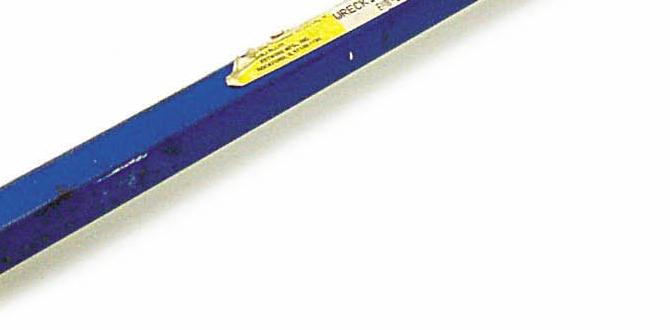Quick Summary: Create powerful DIY garden fertilizer using common household scraps to nourish your soil and boost plant growth naturally. These eco-friendly methods are simple, cost-effective, and perfect for beginners looking to give their plants an essential boost.
Ever feel like your plants are just… okay? You water them, give them sunshine, but they don’t quite have that vibrant, lush look you see in magazines. It’s a common feeling for many gardeners, especially when starting out. Sometimes, all your green friends need is a little extra food! But buying commercial fertilizers can get expensive, and figuring out what your plants actually need can feel like a guessing game. What if I told you that you likely have a treasure trove of plant-boosting power right in your kitchen or backyard? Get ready to transform your garden with simple, homemade fertilizers that are kind to your wallet and the planet.
Unlock Your Garden’s Potential with DIY Fertilizer
Think of fertilizer as a healthy meal for your plants. Just like we need a balanced diet, plants need specific nutrients to grow strong, produce beautiful flowers, and yield delicious fruits or vegetables. Nitrogen (N) helps with leafy green growth, phosphorus (P) is crucial for root and flower development, and potassium (K) supports overall plant health and disease resistance. These are the “big three” – the macronutrients your plants crave most.
While store-bought options are readily available, many gardeners are discovering the immense benefits of making their own fertilizers. It’s not just about saving money; it’s about control and sustainability. You know exactly what’s going into your soil, avoiding synthetic chemicals and reducing waste. Plus, the satisfaction of seeing your plants thrive on nourishment you created yourself is incredibly rewarding!
This guide is designed to make DIY fertilizing easy for everyone, whether you’re tending a small balcony herb garden or a sprawling backyard vegetable patch. We’ll walk through simple, effective recipes using everyday items. Let’s dig in!
The Magic of Homemade Nutrients
The beauty of DIY fertilizer is that it taps into the natural cycle of nutrients. Many organic materials are rich in essential elements that plants need. By composting, brewing, or simply incorporating specific scraps, you’re feeding your soil biology, which in turn feeds your plants.
Here are some of the most accessible and effective natural ingredients you can use:
- Kitchen Scraps: Vegetable peels, fruit rinds, coffee grounds, tea leaves, eggshells.
- Yard Waste: Grass clippings, fallen leaves, garden trimmings.
- Animal By-products: Aged manure (from herbivores like cows, horses, rabbits, chickens), fish scraps (if you can get them!).
- Other Household Items: Bananas, Epsom salts, molasses, wood ash.
Each of these brings unique benefits. For instance, coffee grounds are packed with nitrogen, while banana peels offer potassium. Eggshells provide calcium, which helps prevent blossom-end rot in tomatoes and peppers. It’s like creating a custom nutrient smoothie for your garden!
Essential DIY Fertilizer Recipes for Beginners
Let’s get our hands dirty with some simple, proven recipes. These are perfect for warming up to the idea of DIY fertilizing and seeing the fantastic results for yourself.
1. Compost Tea: The Liquid Gold Standard
Compost tea is a liquid extract of compost, brimming with beneficial microbes and soluble nutrients. It’s fantastic for foliar feeding (spraying directly on leaves) or drenching the soil. This is arguably one of the most potent and easy-to-make liquid fertilizers.
What You’ll Need:
- A large bucket (at least 5 gallons)
- Screening material – a large mesh bag, old pillowcase, or burlap sack
- Mature, finished compost (about 1-2 cups per gallon of water)
- Water (rainwater or dechlorinated tap water is best)
- An aerator (optional, but highly recommended for best results) such as an aquarium pump with an airstone.
Instructions:
- Fill your bucket about halfway with water.
- Place your compost into the mesh bag and tie it securely.
- Submerge the compost bag into the water.
- If using an aerator, place the airstone in the bottom of the bucket and turn the pump on. This keeps the beneficial microbes alive and multiplies them. Let it bubble for 24-48 hours. If you don’t have an aerator, steep the compost bag in the water for 2-3 days, stirring vigorously a few times a day.
- Once brewed, remove the compost bag (you can add the contents to your compost pile). The liquid is your compost tea!
- Dilute the tea with more water until it’s the color of weak tea before applying.
When to Use:
Apply every 2-4 weeks during the growing season. It’s gentle enough for seedlings and effective for mature plants.
2. Coffee Ground Fertilizer: A Nitrogen Powerhouse
Used coffee grounds are slightly acidic and rich in nitrogen, a key nutrient for vibrant green leaves. They also improve soil structure and drainage.
How to Use:
- Direct Application: Sprinkle a thin layer of dried coffee grounds around the base of acid-loving plants like blueberries, azaleas, rhododendrons, and roses. Lightly incorporate them into the top layer of soil. Avoid piling them up, as a thick layer can prevent water penetration.
- Compost Booster: Add coffee grounds to your compost bin. They are considered a “green” material, providing nitrogen to balance “browns” like dead leaves and cardboard.
- Coffee Ground Tea: Steep about 2 cups of used coffee grounds in 5 gallons of water for 2-3 days, stirring occasionally. Strain and use this liquid to water your plants.
Tips:
Ensure grounds are fully dried to prevent mold. While slightly acidic, the acidity is largely neutralized once used and brewed, making them suitable for most plants in moderation. As a general guideline, aim for no more than 1/4 of your compost mix to be coffee grounds to maintain balance.
3. Banana Peel Fertilizer: Potassium Boost
Banana peels are surprisingly rich in potassium, which is vital for flowering, fruiting, and overall plant hardiness. They also contain phosphorus and calcium.
Recipes:
- Banana Peel “Tea”: Chop 2-3 banana peels into small pieces. Place them in a jar or jug and cover with water. Let it steep for 2-3 days. Strain the liquid and use it to water your plants.
- Buried Peels: Cut fresh banana peels into small pieces and bury them directly in the soil near the base of plants, especially roses and tomatoes, which love potassium. They will decompose and release nutrients.
- Dried & Ground: Dry banana peels completely (in a low oven or dehydrator) and then grind them into a powder. Sprinkle this powder into the soil or add it to your compost.
Best For:
Tomatoes, peppers, roses, and flowering plants benefit most from the potassium boost. It helps produce more blooms and fruit, and can help prevent issues like blossom-end rot in tomatoes.
4. Eggshell Fertilizer: The Calcium Source
Eggshells are an excellent source of calcium carbonate, essential for strong cell walls in plants. This helps prevent problems like blossom-end rot in plants like tomatoes, peppers, and squash.
How to Prepare and Use:
- Rinse and Dry: Thoroughly rinse used eggshells to remove any residue. Let them dry completely.
- Crush or Grind: Once dry, you can crush them into small pieces by hand or in a food processor/blender to create a fine powder. The finer the grind, the faster the calcium will become available to your plants.
- Incorporate into Soil: Mix the crushed eggshells into your potting mix or garden soil, especially when planting calcium-dependent crops.
- Compost: Add eggshells to your compost bin. They decompose slowly, providing a long-term calcium release.
- Eggshell Water: Steep crushed eggshells in water for a few days to create a mild calcium-rich liquid fertilizer.
Note: Calcium from eggshells releases slowly into the soil, so it’s best used proactively rather than as an emergency fix. It can take months for the full benefit to be realized.
5. Epsom Salt (Magnesium Sulfate): A Special Treat
Epsom salt is magnesium sulfate, providing plants with magnesium and sulfur. Magnesium is crucial for chlorophyll production (the green in leaves) and phosphorus uptake. Sulfur aids in nutrient absorption.
How to Use:
- Soil Drench: Dissolve 1-2 tablespoons of Epsom salt in a gallon of water. Use this solution to water your plants sparingly, about once a month.
- Seed Starting: Mix a small amount (1 teaspoon per gallon of soil) into your seed-starting mix for stronger seedling development.
Best For:
Tomatoes, peppers, roses, and houseplants often benefit from an occasional Epsom salt boost, especially if they show signs of magnesium deficiency (yellowing leaves with green veins).
Caution: Use Epsom salts in moderation. Too much can harm plants. Avoid using it on plants that prefer acidic soil (like blueberries) unless you’re certain they need magnesium.
DIY Fertilizer vs. Commercial Fertilizer: Key Differences
Understanding the differences can help you make informed choices for your garden’s specific needs. Here’s a quick comparison:
| Feature | DIY Garden Fertilizer | Commercial Fertilizer |
|---|---|---|
| Nutrient Profile | Variable, often broad-spectrum or targeted; relies on natural decomposition. | Precisely measured N-P-K ratios; can be synthetic or organic. |
| Cost | Very Low to Free; utilizes waste materials. | Moderate to High; varies by brand and formulation. |
| Environmental Impact | Low to Positive; reduces waste, avoids synthetic chemicals. | Can be high; synthetic production uses energy, can lead to runoff pollution. |
| Ease of Use | Can require preparation (composting, brewing); results are gradual. | Generally easy to apply (liquids, granules); provides immediate results. |
| Soil Health Impact | Improves soil structure, microbial activity, and long-term fertility. | Primarily feeds the plant directly; can sometimes negatively impact soil biology with overuse of synthetics. |
| Beginner Friendliness | Excellent for simple methods; requires learning organic principles. | Straightforward application; requires careful reading of labels. |
Advanced DIY Fertilizer Techniques (for the Curious Gardener!)
Once you’re comfortable with the basics, you might want to explore more advanced DIY options:
1. Grass Clipping “Tea”
Fresh grass clippings are high in nitrogen. Let them sit in a bucket of water for a few days to create a nitrogen-rich liquid fertilizer similar to compost tea but with a stronger nitrogen punch.
- Process: Fill a bucket about halfway with fresh grass clippings. Add water to cover the clippings. Let it sit for 3-4 days, stirring daily.
- Application: Strain and dilute the liquid with equal parts water before applying to your plants.
- Caution: Use fresh clippings. If they start to rot and smell bad, it’s too far gone. This tea is potent and best used on leafy greens or plants that tend to be a bit pale. Apply every 2-3 weeks.
2. Wood Ash for Potassium and Calcium
From your fireplace or wood stove, untreated, unpainted wood ash can be a source of potassium and calcium. It also helps to raise soil pH, making it beneficial for acidic soils.
How to Use:
- Light Application: Sprinkle a very light dusting of ash around plants and lightly till it into the soil. Too much ash can over-alkalize the soil and harm many plants.
- Compost: Add small amounts of wood ash to your compost bin.
Best For:
Root vegetables like carrots and potatoes, and plants that tolerate or prefer alkaline conditions. Definitely test your soil pH before using wood ash.
Important Note on Wood Ash:
Never use ash from treated lumber, charcoal briquettes, or coal. These can contain harmful chemicals. Wood ash is alkaline, so avoid it around acid-loving plants like rhododendrons, azaleas, and blueberries. Check out resources from university extensions like Penn State Extension for detailed guidance on using wood ash safely and effectively.
3. Molasses Fertilizers
Blackstrap molasses is rich in trace minerals and sugars, which are food for beneficial soil microbes. These microbes then help make nutrients more available to your plants.
Recipe:
- Mix 1-2 tablespoons of unsulfenated blackstrap molasses with a gallon of water.
- Stir until dissolved.
- Water your plants with this solution once a month.
Benefits:
This boosts soil health, encourages microbial life, and provides trace minerals that can improve plant vigor and disease resistance.
When and How to Apply Your DIY Fertilizers
Timing and method are key to maximizing the benefits of any fertilizer, homemade or otherwise. Here are some general guidelines:
- Growing Season: Most plants benefit from regular feeding during their active growing period, typically from spring through late summer. You don’t need to fertilize dormant plants.
- Frequency: For most DIY liquid fertilizers like compost tea or kitchen scrap teas, applying every 2-4 weeks is a good starting point. Solid amendments like crushed eggshells or compost should be mixed into the soil once or twice a year.
- Application Type:
- Soil Drench: Pour diluted liquid fertilizers directly onto the soil around the base of the plant, avoiding the stem. This allows roots to absorb the nutrients.
- Foliar Feed: Spray diluted liquid fertilizers (like compost tea) directly onto the leaves. This is a quick way for plants to absorb nutrients, especially during periods of stress. Spray in the early morning or late evening to prevent leaf scorch.
- Soil Incorporation: Mix solid fertilizers (like crushed eggshells, bone meal, or finished compost) directly into the soil before planting or as a top dressing.
- Observe Your Plants: The best indicator is your plants themselves! Yellowing leaves can indicate a nitrogen deficiency, while stunted growth might suggest a lack of phosphorus. Different plants have different needs, so pay attention to what yours are telling you.
A Note on “N-P-K” for DIY
While DIY fertilizers are fantastic for overall soil health and providing a broad spectrum of nutrients, they don’t typically have a clear N-P-K ratio like commercial fertilizers. This is often a good thing, as it encourages a more balanced approach to feeding. However, if you suspect a specific deficiency (like low nitrogen leading to pale leaves), you can lean towards ingredients known to be rich in that nutrient. For example, coffee grounds and grass clippings are high in nitrogen, banana peels in potassium, and eggshells in calcium.
Troubleshooting Common DIY Fertilizer Issues
Even with the best intentions, things can sometimes go awry. Here are a few common issues and how to fix them:
- Bad Smell: If your compost tea or other liquid concoction smells foul, it likely means it’s gone anaerobic (lacking oxygen). Aerating it thoroughly or discarding it and starting fresh is the best approach. Always aim for an earthy, “fresh earth” smell, not a rotten one.
- Mold: Coffee grounds left in thick, wet clumps can mold. Ensure they are dried before use or spread thinly. Adding moldy materials to a hot compost pile is usually fine, as the heat will kill pathogens.
- Plant Burn: This usually happens from over-fertilizing, especially with potent homemade “teas” or direct applications of strong materials. If you see leaf edges turning brown or crispy, dilute your fertilizer even further or reduce the frequency.
- Lack of Results: Be patient! Organic fertilizers work by feeding the soil microbes, which then make nutrients available to plants. This is a slower process than synthetic fertilizers. Ensure you’re using a variety of materials and feeding your soil consistently.
For more general soil health advice, consider resources from organizations like the USDA Natural Resources Conservation Service.</





